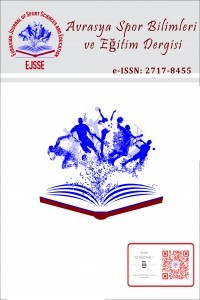Sporda Liderlik Alanında Yapılan Çalışmaların Bibliyometrik Analizi
Liderlik, Antrenörlük, Fiziksel aktivite, Beden eğitimi, Spor
Bibliometric Analysis of the Studies Conducted in the Field of Leadership in Sports
Leadership, Coaching, Physical activity, Physical education, Sport,
___
- Amorose, A.J., & Horn, T. (2000). Intrinsic motivation: Relationships with collegiate athletes' gender, scholarship status, and perceptions of their coaches' behavior. Journal of Sport & Exercise Psychology, 22(1-4), 63-84. https://doi.org/10.1123/jsep.22.1.63
- Bass, B.M., & Stogdill, R.M. (1990). Bass & Stogdill's handbook of leadership: Theory, research, and managerial applications. Simon and Schuster.
- Boyle, F., & Sherman, D. (2006). Scopus™: The product and its development. The Serials Librarian, 49(3), 147-153. https://doi.org/10.1300/J123v49n03_12
- Burnham, J.F. (2006). Scopus database: A review. Biomedical Digital Libraries, 3(1), 1-8. https://doi.org/10.1186/1742-5581-3-1
- Case, B. (1987). Leadership behavior in sport: A field test of the situational leadership theory. International Journal of Sport Psychology, 18, 256-268.
- Chappelet, J.L. (2009). A global vision for sport (and sport management). European Sport Management Quarterly, 9(4), 483-485. https://doi.org/10.1080/16184740903331960
- Chelladurai, P. (1990). Leadership in sports: A review. International Journal of Sport Psychology. https://doi.org/10.1002/9781118270011
- Cotterill, S.T., & Fransen, K. (2016). Athlete leadership in sport teams: Current understanding and future directions. International Review of Sport and Exercise Psychology, 9(1), 116- 133. https://doi.org/10.1080/1750984X.2015.1124443
- Cruz, A.B., & Kim, H.D. (2023). A bibliometric review of coach leadership studies. Frontiers in Psychology, 10 (14), 1-10. https://doi.org/10.3389/fpsyg.2023.1135243.
- Day, D.V., Fleenor, J.W., Atwater, L.E., Sturm, R.E., & McKee, R.A. (2014). Advances in leader and leadership development: A review of 25 years of research and theory. The Leadership Quarterly, 25(1), 63-82. https://doi.org/10.1016/j.leaqua.2013.11.004
- Edwardson, C.L., Winkler, E.A., Bodicoat, D.H., Yates, T., Davies, M.J., Dunstan, D.W., & Healy, G.N. (2017). Considerations when using the activPAL monitor in field-based research with adult populations. Journal of Sport and Health Science, 6(2), 162-178. https://doi.org/10.1016/j.jshs.2016.02.002
- Eren, E. (2014). Örgütsel davranış ve yönetim psikolojisi. Beta Yayıncılık.
- Fransen, K., Vanbeselaere, N., Exadaktylos, V., Vande Broek, G., De Cuyper, B., Berckmans, D., ... & Boen, F. (2012). “Yes, we can!”: Collective efficacy and athlete leadership in sports teams. Journal of Sport & Exercise Psychology, 34, 225-226.
- Gan, J.L., & Yusof, H.M. (2020). A global research trend on leadership in sport: A bibliometric analysis. International Journal of Psychosocial Rehabilitation, 24, 163–170. https://doi.org/10.37200/IJPR/V24I5/PR201679
- Gündoğdu, F., ve Sunay, H. (2018). Türk spor teşkilatındaki spor yöneticilerinin liderlik stilleri. SPORMETRE Beden Eğitimi ve Spor Bilimleri Dergisi, 16(2), 178-195. https://doi.org/10.1501/Sporm_0000000364
- Hancock, G.R., Butler, M.S., & Fischman, M.G. (1995). On the problem of two-dimensional error scores: Measures and analyses of accuracy, bias, and consistency. Journal of Motor Behavior, 27(3), 241-250. https://doi.org/10.1080/00222895.1995.9941714
- Hunt, G.E. (2011). Making sense of bibliometrics. Acta Neuropsychiatrica, 23(2), 80-81. https://doi:10.1111/j.1601-5215.2011.00534.x
- Işık, Ö., ve Serinkan, C. (2020). Liderlik yaklaşımları ve spor yönetiminde liderlik. Pamukkale Üniversitesi İşletme Araştırmaları Dergisi, 7(2), 308-332. https://doi.org/10.47097/piar.824025
- İkizler, C. (2000). Sporda sosyal bilimler. Alfa Yayınevi.
- Özer, K.E. (2019). Etkili liderlik ile duygusal bağlılık ilişkisinde işveren markası algısının aracılık etkisi ve araştırma. Yayımlanmamış Doktora Tezi, İnönü Üniversitesi, Sosyal Bilimler Enstitüsü, Malatya.
- Koruç, Z. (1995). Voleybolda antrenör özellikleri ve antrenör kişiliği. Voleybol Dergisi, 3-8.
- Kozlowski, S.W., Watola, D.J., Jensen, J.M., Kim, B.H., & Botero, I.C. (2009). Developing adaptive teams: A theory of dynamic team leadership. In E. Salas, G. F. Goodwin, & C. S. Burke (Eds.), The organizational frontiers series. Team effectiveness in complex organizations: Cross-disciplinary perspectives and approaches (p.113–155). Routledge
- Krauskopf, E. (2018). A bibiliometric analysis of the Journal of Infection and Public Health: 2008–2016. Journal of Infection and Public Health, 11(2), 224-229. https://doi.org/10.1016/j.jiph.2017.12.011
- Kurtz, M., & Bollen, J. (2010). Usage bibliometrics. Annual Review of Information Science and Technology, 44, 1-64. https://doi.org/10.1002/aris.2010.1440440108
- Mountjoy, M., Brackenridge, C., Arrington, M., Blauwet, C., Carska-Sheppard, A., Fasting, K., ... & Budgett, R. (2016). International Olympic Committee consensus statement: harassment and abuse (non-accidental violence) in sport. British Journal of Sports Medicine, 50(17), 1019-1029. http://dx.doi.org/10.1136/bjsports-2016-096121
- Northouse, P.G. (2018). Leadership: Theory and Practice. Sage publications.
- Salini, S. (2016). An Introduction to Bibliometrics. In T. Greenfield, & S. Greener (Eds.), Research methods for postgraduates (pp. 130-143). John Wiley & Sons, Ltd. https://doi.org/10.1002/9781118763025.ch14
- Samiee, S., & Chabowski, B.R (2012). Knowledge Structure in international marketing: A Multi-method bibliometric analysis. Journal of the Academy of Marketing Science, 40(2), 364-386. https://doi.org/10.1007/s11747-011-0296-8
- Sheehy, T.L., Dieffenbach, K., & Reed, P.L. (2018). An exploration of coaching research in journal of applied sport psychology from 1989 to 2017. Journal of Applied Sport Psychology, 31, 352–365. https:/7doi.org10.1080/10413200.2018.1494642
- Stogdill, R. (1974). Handbook of leadership: A Survey of the literature. Free Press.
- Tunçer, P. (2012). Yönetim ve organizasyon. Beta Yayıncılık.
- Van-Eck, N.J., & Waltman L. (2010). Software survey: VOSviewer, a computer program for bibliometric mapping. Scientometrics, 84(2), 523–538. https://doi.org/10.1007/s11192-009-0146-3
- Web of Science (WoS), (2023). Web of Sicence Platform. 01.05.2023, https://clarivate.com/products/scientific-and-academic-research/research-discovery-and-workflow-solutions/webofscience-platform/
- Yeşil, S. (2013). Küresel ve değişen çevre dinamikleri ışığında yeni yönetim yaklaşımlarından seçme konular. Seçkin Yayıncılık.
- Yetim, A. (1996). Spor yönetiminde liderlik. Gazi Beden Eğitimi ve Spor Bilimleri Dergisi, 1(3), 85-94.
- Yayın Aralığı: Yılda 2 Sayı
- Başlangıç: 2019
- Yayıncı: Nazmi SARITAŞ
Analysis of Global Publications Related to Sport Management Education between 1990-2020
Beden Eğitimi ve Spor Öğretmenlerinin Çoklu Zekâ Kuramına Göre Zekâ Alanlarının İncelenmesi
Çiğdem KARAGÜLMEZ SAĞLAM, Erman DOĞAN
Genç Kuşakların Spor Farkındalığı ile Yaşam Doyumları Arasındaki İlişkinin İncelenmesi
Hacı Şükrü TAŞTAN, Ali Davut ALKAN
The Effect of Adapted Physical Activities on an Individual with Special Need’s Turn-Taking Skills
Bekir Erhan ORHAN, Aydın KARAÇAM, Arif ÇETİN
Sosyal Bilgiler Öğretmenlerinin Geleneksel Sporlara Yönelik Tutum ve Görüşlerinin İncelenmesi
Ahmet TOKMAK, Veysi AKTAŞ, Genç Osman İLHAN
Manchester City’s Start of the Offensive Phase: A Lag-Sequential Analysis
James SCİCLUNA, Renzo KERR-CUMBO, Kemal GÖRAL, Ender ŞENEL
Anaerobik Mesafe Kapasitesi Futbolda Hız, İvmelenme ve Çeviklik Üzerinde Etkili midir?
Muhammet Hakan MAYDA, Erdal ARİ
Yeme Problemi Olan Otizmli Bireylere Uyarlanmış Fiziksel Aktivite ve Beslenme Programı ile Müdahale
How Do Swimming Students' Anthropometric Characteristics Affect Short-Course Swimming Performance
